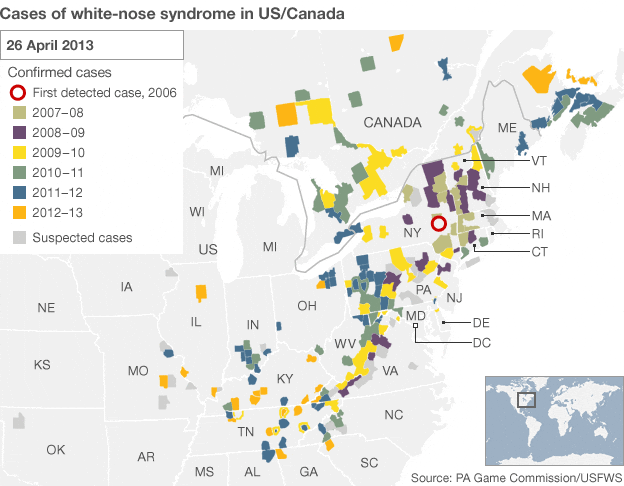- Aug 4, 2011
- 81,129
- 14,024
- 2,190
Please don't pick up or hang out around bats:
"The most widely distributed reservoir of rabies in the United States, however, and the source of most human cases in the U.S., are bats. Nineteen of the twenty-two human rabies cases documented in the United States between 1980 and 1997 have been identified genetically as bat rabies. In many cases, victims are not even aware of having been bitten by a bat, assuming that a small puncture wound found after the fact was the bite of an insect or spider; in some cases, no wound at all can be found, leading to the hypothesis that in some cases the virus can be contracted via inhaling airborne aerosols from the vicinity of bats. For instance, the Centers for Disease Control and Prevention (CDC) warned on May 9, 1997, that a woman who died in October, 1996 in Cumberland County, Kentucky and a man who died in December, 1996 in Missoula County, Montana were both infected with a rabies strain found in silver-haired bats; although bats were found living in the chimney of the woman's home and near the man's workplace, neither victim could remember having had any contact with them.[18"
Prevalence of rabies - Wikipedia, the free encyclopedia
Prompted by spoonman's downed bat photo in the Wildside Pecker's forum...I don't want to derail that thread which is primarily about photographing and discussing wild birds.....but bats DO carry disease, and some of the diseases they carry can be fatal by the time the symptoms show up.
Many people who get lysso virus (of which rabies is one) don't even know how they got it...they aren't aware of being bitten...and by the time they realize, it can be too late for any effective prevention; all that you're going to get is treatment, and crossed fingers.
If a bat is down on the ground at any time, or if you find it in a building where they haven't been before, during the day, please don't catch it or pick it up. Call fish & game or whatever you have and have THEM come and get the thing. They will also test to see if it is harboring any diseases, and that helps them with monitoring the population.
I was in the Dollar Store, for pete's sakes, once with my kids, when one of the cashiers was racing through the store trying to catch a bat. It was full daylight, in fact, a hot summer afternoon...and the bat would fly, then land, then struggle up just as she got to it.
Obviously there was something wrong about it. And she was like "Omg, it's so cute...all that about bats being dangerous is just paranoia, blah blah blah blah". There was obviously a problem with the bat. So why would someone want to handle a sick bat?
I know I didn't appreciate having it chased past 3 year old kid....
"The most widely distributed reservoir of rabies in the United States, however, and the source of most human cases in the U.S., are bats. Nineteen of the twenty-two human rabies cases documented in the United States between 1980 and 1997 have been identified genetically as bat rabies. In many cases, victims are not even aware of having been bitten by a bat, assuming that a small puncture wound found after the fact was the bite of an insect or spider; in some cases, no wound at all can be found, leading to the hypothesis that in some cases the virus can be contracted via inhaling airborne aerosols from the vicinity of bats. For instance, the Centers for Disease Control and Prevention (CDC) warned on May 9, 1997, that a woman who died in October, 1996 in Cumberland County, Kentucky and a man who died in December, 1996 in Missoula County, Montana were both infected with a rabies strain found in silver-haired bats; although bats were found living in the chimney of the woman's home and near the man's workplace, neither victim could remember having had any contact with them.[18"
Prevalence of rabies - Wikipedia, the free encyclopedia
Prompted by spoonman's downed bat photo in the Wildside Pecker's forum...I don't want to derail that thread which is primarily about photographing and discussing wild birds.....but bats DO carry disease, and some of the diseases they carry can be fatal by the time the symptoms show up.
Many people who get lysso virus (of which rabies is one) don't even know how they got it...they aren't aware of being bitten...and by the time they realize, it can be too late for any effective prevention; all that you're going to get is treatment, and crossed fingers.
If a bat is down on the ground at any time, or if you find it in a building where they haven't been before, during the day, please don't catch it or pick it up. Call fish & game or whatever you have and have THEM come and get the thing. They will also test to see if it is harboring any diseases, and that helps them with monitoring the population.
I was in the Dollar Store, for pete's sakes, once with my kids, when one of the cashiers was racing through the store trying to catch a bat. It was full daylight, in fact, a hot summer afternoon...and the bat would fly, then land, then struggle up just as she got to it.
Obviously there was something wrong about it. And she was like "Omg, it's so cute...all that about bats being dangerous is just paranoia, blah blah blah blah". There was obviously a problem with the bat. So why would someone want to handle a sick bat?
I know I didn't appreciate having it chased past 3 year old kid....


